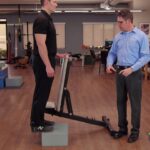Heel Raises | Early Intervention Ergonomics
What are Heel Raises?
Heel raises, also referred to as calf raises or calf exercises, are a widely practiced physical activity that primarily targets the muscles in the posterior lower leg, specifically the calf muscles. Calf muscles consist of two key components: the gastrocnemius, the larger and more superficial muscle, and the soleus, located beneath the gastrocnemius.
Heel raises involve the controlled lifting of one’s body onto the toes while maintaining straight legs. This exercise is often performed as follows:
- Assume a standing position with feet positioned hip-width apart and toes pointed forward.
- Utilize a stable surface, such as a wall, bar, or any form of support, to place your hands for balance and stability.
- Gradually raise your heels off the ground, transferring the weight of your body onto the balls of your feet.
- Maintain the elevated position momentarily, allowing for the sensation of the calf muscles contracting.
- Slowly lower your heels back down to the initial starting position.
Heel raises can be executed using both feet simultaneously or with one foot at a time, depending on personal preference and fitness goals. To intensify the exercise, individuals may opt to incorporate resistance elements such as dumbbells or specialized calf raise machines.
Early Intervention Benefits
Heel raises, or calf raises, offer several early intervention benefits for overall fitness and injury prevention. By incorporating heel raises into your exercise routine, you can:
- Strengthen Calf Muscles: it targets the calf muscles, including the gastrocnemius and soleus, leading to increased strength and endurance.
- Improve Ankle Stability: it engages the muscles surrounding the ankle joint, enhancing stability and reducing the risk of sprains or other ankle-related injuries.
- Enhance Workplace Performance: Strong calf muscles from this stretch can boost performance in work-related activities that involve running, jumping, or quick changes in direction.
- Prevent Shin Splints: Strengthening the calf muscles through this stretch can alleviate strain on the shins, reducing the likelihood of developing painful shin splints.
- Aid Achilles Tendon Health: Regularly performing this stretch can help maintain the health and flexibility of the Achilles tendon, reducing the risk of tendinitis or Achilles-related injuries.
- Promote Balance and Posture: The calf muscles play a significant role in maintaining balance and proper posture. Strengthening them through heel raises can contribute to improved stability and alignment.
- Reduce Lower Leg Injuries: By strengthening the calf muscles and improving ankle stability, this stretch can help prevent common lower leg injuries, such as calf strains or Achilles tendonitis.
Things to Remember
Remember, proper form and gradually increasing intensity are important when performing heel raises to minimize the risk of injury. As always, consult with a healthcare professional or fitness expert before starting any new exercise program.
These early intervention exercises are to improve overall health & fitness as well as help reduce work-related injuries.
If you have an injury or illness, consult with a health care professional before attempting.
Contact us for more information on how we can help your employees stay safe.
More Tools & Resources from Peak Ergonomics
Contact Us About Reducing Workplace Injuries
Healthy Employees are the Bottom Line! – Learn More!

